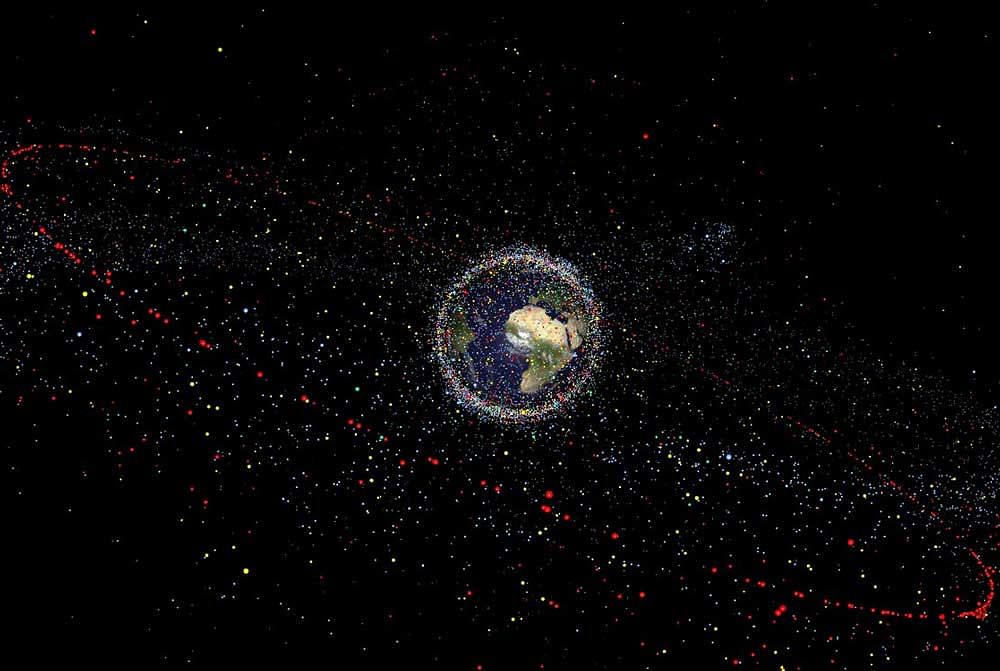Can you imagine that a junk metal piece, as small as a matchbox and one of the estimated 170 million pieces of ‘Space Debris’, can cause serious damage to satellites that are orbiting the earth to render flawless services? The services that satellites and other outer space-based infrastructure provide us vary from Direct-To-Home TV service to telecommunications, internet and weather advisories that save the lives of fishermen, etc. All these could be adversely affected by space debris.
The Space Age began on October 4, 1957, with the launch of the Soviets’ Sputnik 1, the first artificial satellite. Since then, there have been more than 5,200 rocket launches that have placed some 7,500 satellites into orbit. Of them, about 4,300 remain in space today, but only a small fraction — about 1,200 — remain operational. The rest constitute space debris.
Defined as ‘all human-made, non-functioning objects in orbit around Earth’, space debris or junk is estimated to be as much as a combined mass of about 8,135 tonnes circling our planet. The US Space Surveillance Network keeps a track of more than 23,000 objects larger than 5–10 cm in low earth orbit and 30 cm-1 m at geostationary altitudes. The European Space Agency estimated that in all, about 170 million pieces of space debris currently orbit the Earth.
Some chunks are as big as a truck, others smaller than a dime. Travelling at a speed of 8 km/s or more than 30,000 kmph, even the tiniest piece of cosmic junk poses an enormous threat to other satellites and space infrastructure. The density of space debris is reported to be highest in low earth orbit.
Satellites are launched into different orbits, based on their utility. For instance, in geostationary or geosynchronous orbits, the satellite is always positioned, 35,786 kilometres above, over the same spot on Earth and is a valuable spot for monitoring weather, communications and surveillance.
On the other hand, low earth orbits (LEO) between 400 and 1,000 miles above the earth’s surface, are used for data communication such as email, video-conferencing and paging. They move at extremely high speeds and are not fixed in space in relation to Earth.
Worried about the growing hazard of space debris to space infrastructure, Nasa scientist Donald J Kessler proposed in 1978 a scenario where the density of debris in LEO may become high enough that collisions between them could cause a cascade of collisions and render space activities and the use of satellites in specific orbital ranges infeasible for many generations.
Alarmed by the possibility of this ‘Kessler Syndrome’, space-faring nations have formed a group — Inter-Agency Space Debris Coordination Committee (IADC) — and adopted a two-pronged strategy: one, prevention — aimed at preventing the formation of new space debris; and two, the active removal of space debris from orbits.
As part of a preventive strategy, IADC has produced in association with the United Nations Committee on the Peaceful Uses of Outer Space (UNCOPUOS), a set of seven Space Debris Mitigation Guidelines. However, these guidelines alone, without active removal technologies, cannot prevent Kessler Syndrome and ensure sustainability of orbital space.
In other words, it presents a unique business opportunity as well. Encouraged by bright prospects, various players, including government agencies such as Nasa, European Space Agency, Japan Space Agency, entrepreneurs are working on different technologies for active removal of space debris.
Presently, two broad approaches are being tested: capture mechanisms (using nets, harpoons, robotic arms, tentacles, etc) and mechanisms to slow down the speed of debris, which makes them to gradually re-enter the atmosphere and burn up. But they are still in experimental stages.
In June, Japan successfully demonstrated a capture mechanism. From the International Space Station, Japan deployed the Nano Racks-Remove Debris satellite into space. Using a 3D camera to map the location and speed of orbital debris or space junk, it successfully deployed a net to capture a nanosatellite that simulated debris.
Such technological successes certainly bring cheers as space is considered a Global Common and should be used for the overall welfare of the human race. But the entire responsibility of space debris can be attributed to space-faring nations, which are no more than a dozen. Hence, the cost of cleaning up the space debris ought to be the responsibility of those space-faring nations only. International jurisprudence has already evolved various principles to deal with such circumstances.
For instance, global climate change — recognising that a few industrial nations were responsible for the majority of emission, principles such as Common but Differential Responsibilities and the ‘Polluter Pays’ principle became part of international jurisprudence.
The High-Level Forum of United Nations Office of Outer Space Affairs, being convened to discuss the governance issues of outer space, should consider various angles and come out with recommendations to protect and ensure the long-term sustainability of space and its utility for human welfare.
(The writer is a student of aerospace engineering at Jain University, Bengaluru)
